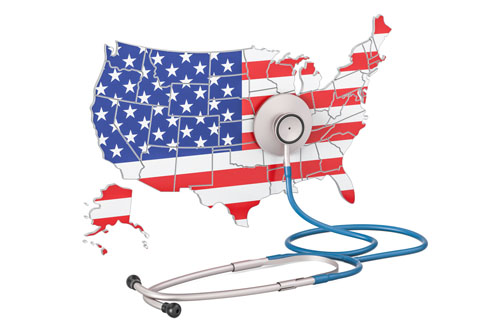The market’s value is projected to total $636.9 billion in 2024, expanding at a compound annual growth rate (CAGR) of 5.96% to reach $802.8 billion in 2028.1
Oncology drugs make up the largest segment of this sector, representing more than one-third of new product launches in 2023.2
Although small molecule drugs still dominate the market, the rate of growth of biologics is higher, representing nearly half of all drug spending.
In addition, most small molecule drug prescriptions are generic … but they account for less than 10% of overall revenues owing to continuing downward pricing pressures.
Meanwhile, the biosimilars segment will experience strong growth, with more than two-thirds of branded molecules facing patent expiries soon.2 Separately, specialty drugs have risen in importance and now account for slightly more than half of US pharma revenues.2
Consumers are also taking a more active role in their healthcare choices, with interest rising in personalised and targeted therapies, as well as natural and alternative remedies.
The United States is expected to remain the centre of global pharma innovation and thus attract foreign buyers.
High levels of competition and consolidation characterise US trade. Combined, the top ten companies –– Johnson & Johnson (J&J), Eli Lilly and Co., AbbVie, Merck & Co., Pfizer, Amgen, Bristol-Myers Squibb (BMS), Gilead Sciences, Vertex Pharmaceuticals and Regeneron Pharmaceuticals –– had a total market capitalisation of $2,060,644 million as of March 2023, but the whole ecosystem teems with start-ups and entrepreneurial ventures that help to drive innovation.3
In 2023, the volume of US pharma merger and acquisition (M&A) activity returned to near prepandemic levels and 2024 will likely be similar, with numerous deals in the $225–275 billion range, along with smaller strategic deals and, potentially, a few larger transactions later in the year.
Anticipated US drug approvals and launches in 2024
Novel drug approvals by the US FDA rose in 2023, reaching a record high of 71. Biologics accounted for just less than half, including the first CRISPR-Cas9–edited cell therapy, as well as gene therapies and bispecific antibodies.
Among small molecules, four new oligonucleotide-based treatments were approved. More than half of all approvals targeted rare diseases. To increase patient access, the FDA approved more than 80 first generics and five biosimilars.
The prognosis for approvals in 2024 looks healthy — based on Prescription Drug User Fee Act (PDUFA) dates — with as many as 59 drugs already showing potential to receive acceptance.
A few expected approvals creating excitement include Moderna’s mRNA-based RSV vaccine, Eli Lilly’s Alzheimer’s drug (Donanemab) and BMS’s schizophrenia therapy (KarXT).
Other anticipated approvals include Madrigal Pharmaceuticals’ resmetirom, Merck’s Sotatercept, Datopotamab from AstraZeneca and Daiichi Sankyo, BridgeBio Pharma’s Acoramidis, ImmunityBio’s Anktiva, Verona Pharma’s Ensifentrine and Iovance Biotherapeutics’ Lifileucel.
Patent cliff impacts
Several key drugs lost patent protection in 2023: AbbVie’s Humira, J&J’s Stelara, Takeda’s Vyvanse and Gattex, Sanofi’s Aubagio, Roche’s Actemra, AstraZeneca’s Symbicort, Gilead’s Lexiscan, Novartis’ Entresto, Amgen’s Otezla, and Novo Nordisk’s Victoza and Saxenda.
More patent expiries for top-selling drugs are coming in the next 5 years, including the biologics Keytruda (Merck), Eylea (Regeneron), Opdivo (BMS), Ocrevus (Roche) and Prolia/XgevaIt (Amgen), and the small molecule drugs Eliquis (BMS, Pfizer), Ibrance (Pfizer), Xarelto (J&J, Bayer) and Trulicity (Eli Lilly).

Approximately $180 billion in sales within the top 20 pharma companies are at risk from patent expirations between now and 2028.4 Biosimilars have seen much wider acceptance by US physicians and patients in recent years.
AbbVie, for instance, has offered rebates on Humira to pharmacy benefit managers to help retain market share; but, its revenues declined by nearly one-third in 2023 compared with 2022, with a similar drop expected for 2024.4
Drugmakers are facing significant pressure to find other sources of revenues in the face of such declines, including acquisitions to expand and diversify their portfolios, developing novel therapies and exploring medical devices.
Additionally, many are pursuing strategies to extend their patent protections and/or delay the entry of generic/biosimilar competition.
Ongoing generics shortages
The US generics market was valued at $90.4 billion in 2023 and is estimated to be expanding at a CAGR of 3.5% to reach $124.3 billion by 2032 — despite downward pricing pressure owing to the rising incidence of chronic diseases and the continued loss of patent protections.5
Branded prescription drugs are estimated to be nearly 2.5 times more expensive for US patients than for consumers in similar markets; and, because generics are cheaper, those low prices are threatening the sustainability of the market.
Many producers have withdrawn from the market, leaving just one or two suppliers of many generic drugs. In addition, because competition is generally defined only by cost, most players still in the business outsource to contract manufacturers in Asia.
However, quality and manufacturing problems have become real issues and have led to a large number of drug shortages for many important medicines.
For some of these drugs, no alternatives are available, leading physicians to ration care and leaving some patients without much-needed medicines.
Healthcare reform and other legislative headwinds
Despite the troubles within the generics market owing to low drug pricing, new healthcare policies and proposed legislation aim to keep drug prices down — or at least control them.
One bill aims to prevent patent extensions via minor formulation adjustments known as “patent hopping,” whereas another aims to set a price limit for insulin and a third would ensure pharmacy benefit managers receive a flat fee per drug rather than a percentage of its price.

Several others aim to help increase price transparency for consumers. The Inflation Reduction Act is expected to increase demand for new vaccines and biologics but negatively impact patient access to, and affordability of, care while also impeding the development of drugs for rare diseases.
The first 10 drugs that the government will negotiate prices for are Eliquis, Jardiance, Xarelto, Januvia, Farxiga, Entresto, Enbrel, Imbruvica, Stelara and insulin.6 Price cuts will range from 25–65% and will go into effect in 2026.
The Biden Administration has taken several other actions, including heightened scrutiny in terms of deal making in the pharma industry and challenging “improper” drug patents listed in the FDA’s Orange Book.
It may also pursue “march-in” authority to break patents on drugs developed with taxpayer money and seek rebates for drugs for which price increases outpace inflation.
Declining reimbursement rates have also been identified as a real threat to the US industry. Finding ways to increase consumer understanding of the costs of drug development — and other components of healthcare — remains a significant issue.
At the same time, pharma companies will need to transition their business models from a focus on products to providing solutions for patients. Otherwise, the recent layoff trend (115 biotech firms announced layoffs in 2023, an increase from 2022) will continue, with severe consequences.7
US regulatory environment
Regulatory guidance issued by the FDA in 2023 and anticipated 2024 actions will impact the pharmaceutical industry during this year and beyond.
The FDA announced initiatives on artificial intelligence (AI) and machine learning in 2023. President Biden also issued an executive order promoting safety and security regarding the use of AI.
The permanent adoption of practices implemented during the COVID-19 pandemic and continued acceptance of advanced manufacturing technologies are also anticipated. Increasing the diversity of clinical trial participants and decentralising clinical studies are also of growing import to regulators.
Emphasis on pharmacovigilance, the agency’s Support for Clinical Trials Advancing Rare Disease Therapeutics pilot programme and implementation of the Drug Supply Chain Security Act will also impact drug manufacturers in 2024.
At the state level, data security in the healthcare industry is expected to be a primary focus.
R&D highlights
Despite the numerous headwinds facing US drug developers, they continue to invest in R&D to discover novel compounds with the potential to treat and possibly cure diseases that remain unaddressed.
Significant efforts to overcome manufacturing challenges for cell and gene therapies will hopefully enable the FDA’s prediction of approving at least 10 of these products each year beginning in 2025.
CRISPR gene-editing, bispecifics, antibody–drug conjugates, mRNA therapies and vaccines, and tackling manufacturing challenges for cell and gene therapies drive intense R&D activity.
Weight-loss drugs will continue to receive significant attention, along with a shift from general therapies to precision medicines.
Automation, advanced analytics and integrated digital solutions to overcome pharmacovigilance and manufacturing challenges will be important going forward.
Headwinds countered by strong foundation
There is great uncertainty surrounding the future of the US pharmaceutical industry; this is because of price controls and other governmental actions, loss of patent protection for many blockbuster drugs, worldwide geopolitical uncertainty, domestic political division and turmoil, and increasing regulatory enforcement.
Strong growth is still expected, owing to the unique strengths of the US industry, including its
- fast pace of innovation
- high level of investment in R&D
- supportive ecosystem
- willingness to take risks
- encouragement of start-ups
- access to funding l transparency
- IP protection
- strong regulatory structure backed by leading-edge regulatory science
- sizeable and diverse population.
References
- www.insights10.com/report/us-pharmaceutical-market-analysis/.
- www.iqvia.com/locations/united-states/blogs/2023/07/insights-into-the-2023-us-pharmaceutical-market.
- www.globaldata.com/companies/top-companies-by-sector/healthcare/us-companies-by-market-cap/.
- www.cnbc.com/2024/01/28/big-pharma-merck-bristol- myers-jj-prepare-to-lose-revenue.html.
- www.imarcgroup.com/us-generics-market.
- https://fticommunications.com/2024-healthcare-life-sciences-industry-outlook-biopharma-at-crossroads/.
- www.forbes.com/sites/ritanumerof/2023/08/22/mass-layoffs-continue-across-the-biotech-sector-what-does-this-mean-for-pharmas-future/?sh=6bc710b043fa.
